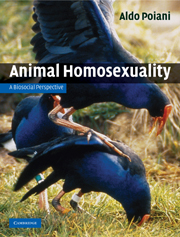Book contents
- Frontmatter
- Dedication
- Contents
- Contributors
- Acknowledgements
- Preface
- 1 Animal homosexuality in evolutionary perspective
- 2 The comparative study of homosexual behaviour
- 3 Genetics of homosexuality
- 4 Ontogenetic processes
- 5 The endocrine and nervous systems: a network of causality for homosexual behaviour
- 6 Immunology and homosexuality
- 7 Sexual segregation effects
- 8 The social, life history and ecological theatres of animal homosexual behaviour
- 9 Homosexual behaviour in primates
- 10 A Biosocial Model for the evolution and maintenance of homosexual behaviour in birds and mammals
- Appendix 1 Glossary
- Appendix 2 Predictions of the Synthetic Reproductive Skew Model of Homosexuality and results obtained in the comparative tests of the model carried out in birds and mammals
- Appendix 3 Comments on further results of comparative analyses of independent contrasts reported in the full correlation matrices of birds and mammals
- References
- Index
- Plates
9 - Homosexual behaviour in primates
Published online by Cambridge University Press: 05 July 2014
- Frontmatter
- Dedication
- Contents
- Contributors
- Acknowledgements
- Preface
- 1 Animal homosexuality in evolutionary perspective
- 2 The comparative study of homosexual behaviour
- 3 Genetics of homosexuality
- 4 Ontogenetic processes
- 5 The endocrine and nervous systems: a network of causality for homosexual behaviour
- 6 Immunology and homosexuality
- 7 Sexual segregation effects
- 8 The social, life history and ecological theatres of animal homosexual behaviour
- 9 Homosexual behaviour in primates
- 10 A Biosocial Model for the evolution and maintenance of homosexual behaviour in birds and mammals
- Appendix 1 Glossary
- Appendix 2 Predictions of the Synthetic Reproductive Skew Model of Homosexuality and results obtained in the comparative tests of the model carried out in birds and mammals
- Appendix 3 Comments on further results of comparative analyses of independent contrasts reported in the full correlation matrices of birds and mammals
- References
- Index
- Plates
Summary
Any attempt at understanding human homosexuality must also include a thorough analysis of same-sex sexual behaviour in the other primates. It is this comparative approach that can uncover those aspects that are common to all or some primates and those that are unique to any particular species. The theory of evolution predicts similarities of traits among closely related taxa due to common descent; it also predicts the possibility of evolutionary convergence among not so closely related taxa if their evolutionary history has unfolded under similar environmental conditions. A further prediction concerns divergences in traits, including behaviour, due to phylogenetic effects, drift and adaptive responses to diverse environmental, including social, circumstances. In this chapter I firstly consider homosexual behaviour as it applies to the non-human primates. This comparative approach may help us to better understand those aspects of human homosexuality that are unique and those that are shared with our closest living relatives. With these thoughts in mind, I start with an introduction to primate diversity and evolution.
Primate diversity and evolution
More than 300 extant species of primate have been described; the precise numbers depend upon the propensity to either ‘split’ or ‘lump’ taxa in various classification schemes. All these species, however, may be assigned to one of six major groupings or superfamilies of the Order Primates: the lemurs of Madagascar (Lemuroidea), the galagos and lorises of Africa and Asia (Lorisoidea), the tarsiers of SE Asia (Tarsioidea), New World monkeys (Ceboidea), Old World monkeys (Cercopithecoidea) and the apes and humans (Hominoidea). Phylogenetic relationships between these six superfamilies are shown diagrammatically in Figure 9.1. George Gaylord Simpson (1945) divided the Order Primates into two suborders: the Prosimii (lemurs, lorises, galagos and tarsiers) and the Anthropoidea (monkeys, apes and humans).
- Type
- Chapter
- Information
- Animal HomosexualityA Biosocial Perspective, pp. 381 - 400Publisher: Cambridge University PressPrint publication year: 2010
- 18
- Cited by



